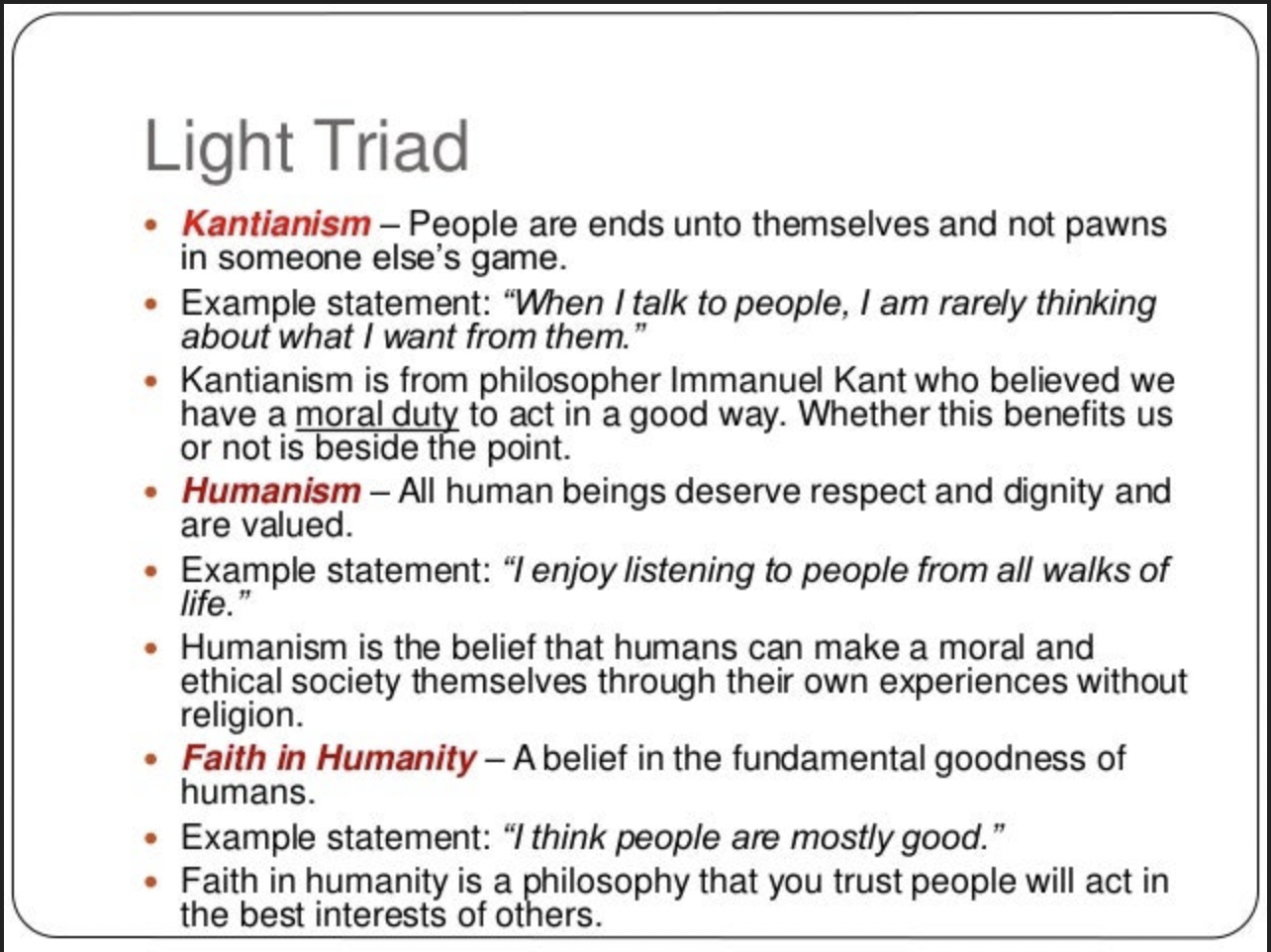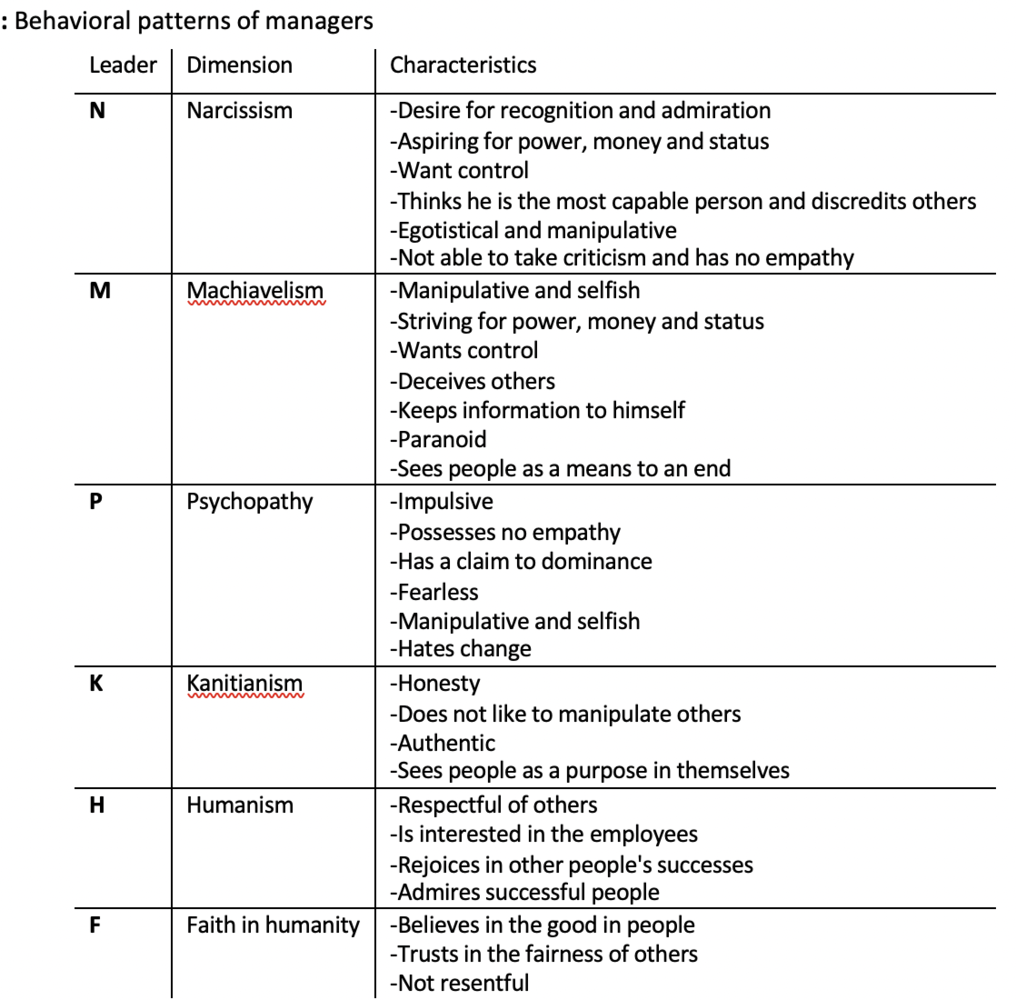Researchers and writers like myself have brought attention the damage that “toxic” and self-serving leaders have done in organizations and institutions and how they can spread like a virus. Unfortunately we all too often see examples of this today.
It doesn’t discount or minimize the large numbers of leaders of good character and ethical behavior. I’ve had the fortune of having met, trained and coached many of them over the last 30 years.
This article looks at a more recent trend and focus: on the “Light Triad” of personality, which when we incorporate into our daily lives, choose leaders and make it part of organizational culture, will make the world of difference.
The “Dark Triad”
Two decades ago psychologists came up with the now infamous “dark triad” of personality traits to understand why some people don’t think twice before cheating on a test or picking on someone weaker than them. Since then researchers have seized upon this trio – namely narcissism, Machiavellianism, and psychopathy – investigating how they relate to a variety of things including workplace success, relationship troubles, and even the seven deadly sins.
Psychologists, philosophers and spiritual leaders throughout our history have argued that we all have, within each of us, both a light and a dark side. Having said that, it’s also true that the degree of each varies with individuals.
For over the past few decades there has been a flurry of empirical research on a number of “dark traits” that are associated with ethically, morally, and socially aversive beliefs and behaviors. There is an emerging consensus that the “dark core” (or so-called “heart of darkness”) of these dark traits consists of an antagonistic social strategy characterized by high levels of interpersonal manipulation and callous behavior. In more recent years this has been referred to as the “Dark Triad” of personality: narcissism, Machiavellianism, and subclinical psychopathy to which sadism and spitefulness has been added.
The “Light Triad” and the Good Person
First of all, let’s clarify what we mean by a good person and good qualities. We are not talking about someone that publicly gives or donates in order to raise their profile or self-esteem. Or someone who gives to others to feel better about themselves.
“I’m talking about the person who, just by their being, shines their light in every direction. The person who isn’t constantly strategic about their giving, but who emits unconditional love naturally and spontaneously because that’s just who they are.” Says Scott Barry Kaufman, one of the lead researchers examining the “Dark Triad” and the “Light Triad.”
Scott Barry Kaufman and colleagues published their study titled “The Light vs. Dark Triad of Personality: Contrasting Two Very Difference” in the journal Frontiers of Psychology.
“Too much focus on one aspect of human nature at the expense of the other misrepresents the full capacities of humanity,” they write. Through four studies featuring more than 1,500 online participants, Kaufman and his team have created a new questionnaire that taps what they are calling the Light Triad (you can take the test online). They’ve also provided preliminary evidence for the kind of personal characteristics and psychological outcomes that are associated with being a high scorer on the light side of personality – or what they call an “everyday saint”.
The research involved participants rating their agreement with statements designed to tap into the more positive, compassionate and selfless aspects of human personality. Kaufman’s team took inspiration for these items from surveys used to measure the Dark Triad, but they made sure that their new items were not simply the Dark Triad questionnaire items in reverse; they also sought advice from experts in positive psychology and personality psychology to help them with the compilation. Participants also completed established measures of the Dark Triad, of the Big Five personality traits, and various other measures of psychological outcomes, well-being, values and characteristics.
The “light triad” being investigated by Kaufman and his colleagues comprises three personality traits that together paint a picture of someone’s overall character. Each of the traits highlight a different aspect of how you interact with others: from seeing the best in people and being quick to forgive, to applauding the successes of others, to being uncomfortable manipulating people into doing something you want.
The new 12-item Light Triad scale that the researchers settled on after removing redundant items taps three light traits: Kantianism, Humanism and Faith in Humanity.

The participants’ scores on the Light Triad traits were negatively correlated with their scores on the Dark Triad traits, but only modestly, suggesting that each is not merely the mirror opposite of the other, and that we all have varying levels of both light and dark traits. On an uplifting note, Kaufman and his colleagues found that their participants’ scores were skewed more towards scoring higher on the Light Triad than the Dark. “Extreme malevolence was rare in the samples we studied,” they write.
The researchers “contrasted the network of the Dark Triad (a well-studied cluster of socially aversive traits) with the network of the Light Triad, measured by the 12-item Light Triad Scale (LTS).” The authors propose that “The LTS is a first draft measure of a loving and beneficent orientation toward others (‘everyday saints’) that consists of three facets: Kantianism( treating people as ends unto themselves), Humanism (valuing the dignity and worth of each individual), and Faith in Humanity (believing in the fundamental goodness of humans).”

Kaufman and colleagues argue that “Across four demographically diverse samples (N = 1,518), the LTS demonstrated excellent reliability and validity, predicting life satisfaction and a wide range of growth-oriented and self-transcendent outcomes above and beyond existing measures of personality. In contrast, the Dark Triad was negatively associated with life satisfaction and growth-oriented outcomes, and showed stronger linkages to selfish, exploitative, aggressive, and socially aversive outcomes.”
Leaders possessing the Dark Triad create a variety of negative and damaging outcomes including “including aggression and violence; low affective empathy; strong motives for self-enhancement; self-serving power; hedonism; short-term counterproductive and coercive behaviors in the workplace; a heartless ‘love style’ characterized by high levels of infidelity; and immature defense mechanisms,” various researchers report.
Overall, and consistent with past research, younger participants, men, those motivated by power, sex, and selfish ambitions, were more likely to score higher on the Dark Triad. In turn, high scorers on the Dark Triad also tended to score lower on life satisfaction, agreeableness, self-transcendent values, compassion, empathy and belief in the good of humanity. More advantageously (in certain contexts), higher scorers on the Dark Triad also reported more casual sexual partners, greater creativity, bravery, assertiveness and leadership.
On the other hand, older people, women, those with more stable childhoods, and the more religious and spiritual, tended to score higher on the Light Triad. In turn, scoring highly on the Light Triad was associated with various appealing and beneficial qualities, such as higher life satisfaction, relationship satisfaction, feelings of autonomy and competence, higher conscientiousness, compassion, empathy, openness, humility and belief in the goodness of others.
Overall, though, Kaufman and his colleagues said that scoring higher on the Light Triad than Dark is associated with a greater quality of life, and they added “we believe that Light Triad individuals are more enjoyable to be around and likely to exert a more positive net effect on the world.”
Dr Kaufman also said in an interview with Scientific American “Interventions that shift perspective, and increase a sense of universal love and self-transcendence,” could have this effect, he said. “This could include engaging regularly in a loving-kindness meditation, using new virtual reality technologies to engage in self-transcendent experiences – such as awe (e.g., viewing images that are beautiful or inspiring), and even intentionally engaging in the perspectives of others that are very different from ours with rational compassion, curiosity, and loving-kindness.”
Increasing self-compassion could be another route to increase Light Triad traits, Kaufman added, considering the strong correlation he and his colleagues found “between thinking that one’s own self is good and thinking that others are basically good”.
Peter Meidl and colleagues looked at the issue of moral behavior and personality in their research published in the Journal of Research in Personality in which they found that people tend to be morally consistent in the short term, over a longer time period there could be room for manoeuvre.
Janis Kaletta and Kevin Reuther published a study titled “The Dark Triad to the Light Triad in the context of Agile Leadership” in organizations. They argue that “Agile leadership can only be practiced successfully by following agile values: courage, focus, respect, openness, appreciation, and trust. Together with the team and the manager, employees organize their own work and learning processes. In parallel, the supervisor becomes mentors helping employees to set individual goals, support them when problems arise and inspire them to improve continuously.”
They then examined the behavioral patterns of managers in relation to the dark and light characteristics.

The authors conclude “This paper poses the question whether dominant and assertive ‘evil’ leaders or rather ‘good’ empathic leaders are the right ones to lead in an agile way in today. To answer this question on the theoretical level, the behaviors of each dimension are compared with the agile values and the extent to which they harmonize with each other is examined. Since adherence to the values is of great importance, it can be deduced who is more capable to lead successfully in an agile manner. As the analysis showed, the characteristics of leaders with light traits harmonize better with the agile values than those of ‘dark leaders’. Therefore, it can be concluded that “’light leaders’ are more capable.
The reason for the better compatibility is that the agile leadership style puts people first and focuses on interpersonal connections. Prosocial behavior of the light triad is a better fit for the agile leadership style. With trust, honesty, respect, and interest, these supervisors are more capable to build interpersonal relationships.The dark personality traits, due to their lack of empathy, selfish nature, and urge to manipulate, are unable to behave according to the values and thus successfully practice agile leadership, build healthy interpersonal relationships, and develop organizations. There is a danger for organizations when leaders with dark characteristics undermine the agile leadership style, for example, through lack of transparency and manipulative behavior, as this can quickly lead to dissatisfaction and a decline in productivity. However, it is difficult to identify and subsequently eliminate these “dark leaders” as they are good at disguising their truemotivations.”
In my book, Toxic Bosses: Practical Wisdom for Developing Wise, Ethical and Moral Leaders, I describe how our organizational cultures need to be ones that manifest virtuous, moral and ethical behavior. That means identifying good character as a key requirement for our leaders. I also suggest the following:
Here are some more suggestions on how society in general and organizations and their leaders specifically can emphasize to a greater degree guiding principles for moral, ethical and wise behavior:
- Place an emphasis on integrity in behaviors—demand it of ourselves and those who we work with and lead us.
- Stop recruiting overconfident, narcissistic and sociopathic/psychopathic people for leadership positions in our institutions and organizations, and opt instead for the honest, humble and compassionate leaders, those who exhibit the “Light Triad” qualities.
- Recruit and promote more women into leadership positions. Research has shown that female leaders are less prone to corrupt and unethical behavior.
- Encourage business schools to put more emphasis on the study of humanities including philosophy and ethics; provide more support for the humanities in post-secondary education rather than the current emphasis on technical knowledge and expertise in business.
- Encourage business leaders (and their employees) to become more involved in worthy causes that benefit society and the planet that are not tied to economic or financial gain.
- Emphasize the importance of developing self-awareness and emotional intelligence in leadership development programs and training.
- Engage in “good conversations” about moral values, and ethical behavior.
- Work as a volunteer on an issue or project that benefits others, humanity and/or the planet without the need for recognition or compensation.
- Actively engage in the responsibilities of being a citizen in a democracy.
- Be an advocate for justice and fairness for all.

